
African art describes the modern and historical paintings, sculptures, installations, and other visual culture from native or indigenous Africans and the African continent. The definition may also include the art of the African diasporas, such as: African-American, Caribbean or art in South American societies inspired by African traditions. Despite this diversity, there are unifying artistic themes present when considering the totality of the visual culture from the continent of Africa.

Equatorial Guinea's culture has been less documented than most African countries, and commercial recordings remain scarce.

The Teke people or Bateke, also known as the Tyo or Tio, are a Bantu Central African ethnic group that speak the Teke languages and that mainly inhabit the south, north, and center of the Republic of the Congo, the west of the Democratic Republic of the Congo, with a minority in the south-east of Gabon. Omar Bongo, who was President of Gabon in the late 20th century, was a Teke.
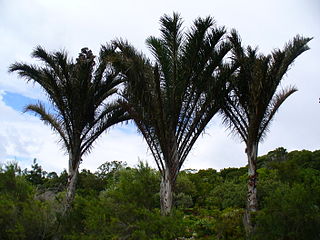
Raffia palms are a genus of about twenty species of palms native to tropical regions of Africa, and especially Madagascar, with one species also occurring in Central and South America. R. taedigera is the source of raffia fibers, which are the veins of the leaves, and this species produces a fruit called "brazilia pods", "uxi nuts" or "uxi pods".
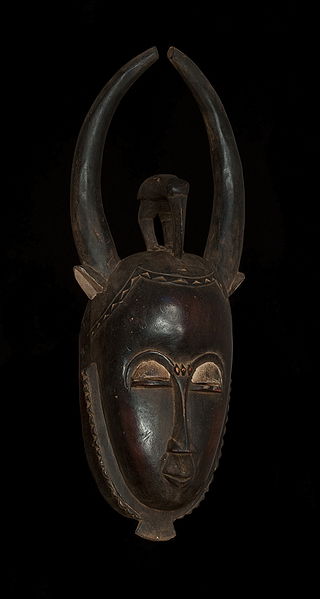
The Baule or Baoulé are a Akan people and one of the largest ethnicities in Côte d'Ivoire. The Baoulé are traditionally farmers who live in the centre of Côte d'Ivoire, in a French braid shaped region between the rivers Bandama and N'Zi. This area broadly encompasses the regions around the cities of Bouaké and Yamoussoukro. The Baoulé have come to play a relatively important role in the recent history of Côte d'Ivoire: the State's first President, Félix Houphouët-Boigny, was a Baoulé; additionally, since the Ivorian cocoa boom of the 1960-1970s, the Baoulé have also become one of the most widespread ethnicities throughout the country, especially in the Southern forests where they are amongst the most numerous planters of cocoa, rubber, and coffee and sometimes seem to outnumber the local native ethnic groups.

The Fang people, also known as Fãn or Pahouin, are a Bantu ethnic group found in Equatorial Guinea, northern Gabon, and southern Cameroon. Representing about 85% of the total population of Equatorial Guinea, concentrated in the Río Muni region, the Fang people are its largest ethnic group. The Fang are also the largest ethnic group in Gabon, making up about a quarter of the population.

The Kuba Kingdom, also known as the Kingdom of the Bakuba or Bushongo, is a traditional kingdom in Central Africa. The Kuba Kingdom flourished between the 17th and 19th centuries in the region bordered by the Sankuru, Lulua, and Kasai rivers in the heart of the modern-day Democratic Republic of the Congo.
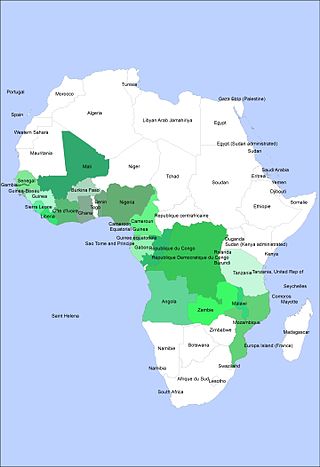
Traditional African masks play an important role in ceremonies, rituals, and masquerades across West, Central, and Southern Africa. Ceremonies in which masks are worn include harvest celebrations, funerals, rites of passage, weddings, and coronations. In some societies, masks and masquerades are also used to settle disputes and communal conflicts.

Most African sculpture was historically in wood and other organic materials that have not survived from earlier than at most a few centuries ago; older pottery figures are found from a number of areas. Masks are important elements in the art of many peoples, along with human figures, often highly stylized. There is a vast variety of styles, often varying within the same context of origin depending on the use of the object, but wide regional trends are apparent; sculpture is most common among "groups of settled cultivators in the areas drained by the Niger and Congo rivers" in West Africa. Direct images of African deities are relatively infrequent, but masks in particular are or were often made for traditional African religious ceremonies; today many are made for tourists as "airport art". African masks were an influence on European Modernist art, which was inspired by their lack of concern for naturalistic depiction.

African folk art consists of a variety of items: household objects, metal objects, toys, textiles, masks, and wood sculpture. Most traditional African art meets many definitions of folk art generally, or at least did so until relatively recent dates.
The Songye people, sometimes written Songe, are a Bantu ethnic group from the central Democratic Republic of the Congo. They speak Songe language. They inhabit a vast territory between the Sankuru/Lulibash river in the west and the Lualaba River in the east. Many Songye villages can be found in present-day East Kasai province, parts of Katanga and Kivu Province. The people of Songye are divided into thirty-four conglomerate societies; each society is led by a single chief with a Judiciary Council of elders and nobles (bilolo). Smaller kingdoms east of the Lomami River refer to themselves as Songye, other kingdoms in the west, refer to themselves as Kalebwe, Eki, Ilande, Bala, Chofwe, Sanga and Tempa. As a society, the people of Songye are mainly known as a farming community; they do, however, take part in hunting and trading with other neighboring communities.

The Okuyi is a rite of passage practised by several Bantu ethnic groups in different countries mainly across the west coast of Central Africa. Some of the countries where the rite is exercised include Cameroon in West Central Africa, Gabon and Equatorial Guinea. Traditionally, the rite is performed at numerous special occasions including funerals and weddings. Usually when an infant reaches four months of age or when a child becomes an adolescent, an Okuyi ritual is applied as well. Today, the Mekuyo rite is exercised by a range of ethnic peoples within the Bantu cluster. The coastal community known as Ndowe, also known as playeros, is a primary example, as peoples across Equatorial Guinea frequently perform the ritual in public. Gabon has two chief ethnic groups that exercise the Okuyi rite including the Mpongwe and Galwa from Lambaréné, Gabon. The man in the custome is usually the leader of the group.

An adorned wood face mask from the We (Wee) people of West Africa, dated to the 20th century is in the permanent African collection at the Indianapolis Museum of Art and on display in the Eiteljorg Suite of African and Oceanic Art.

Kuba art comprises a diverse array of media, much of which was created for the courts of chiefs and kings of the Kuba Kingdom. Such work often featured decorations, incorporating cowrie shells and animal skins as symbols of wealth, prestige and power. Masks are also important to the Kuba. They are used both in the rituals of the court and in the initiation of boys into adulthood, as well as at funerals. The Kuba produce embroidered raffia textiles which in the past was made for adornment, woven currency, or as tributary goods for funerals and other seminal occasions. The wealth and power of the court system allowed the Kuba to develop a class of professional artisans who worked primarily for the courts but also produced objects of high quality for other individuals of high status.
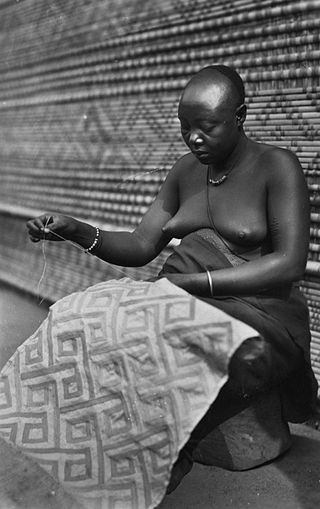
Kuba textiles are a type of raffia cloth unique to the Democratic Republic of the Congo, formerly Zaire, and noted for their elaboration and complexity of design and surface decoration. Most textiles are a variation on rectangular or square pieces of woven palm leaf fiber enhanced by geometric designs executed in linear embroidery and other stitches, which are cut to form pile surfaces resembling velvet. Traditionally, men weave the raffia cloth, and women are responsible for transforming it into various forms of textiles, including ceremonial skirts, ‘velvet’ tribute cloths, headdresses and basketry.
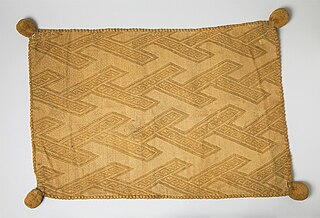
In the Kongo Kingdom and its vassals, the woven arts were emblematic of kingship and nobility. The coarse filament stripped from the fronds of the raffia palm tree served as the foundation of the Kongo weaving arts. This material imposed constraints that were overcome to produce varied and ingenious textile formats and structures. Raffia cloth was used as currency.

The Beti people are a Central African ethnic group primarily found in central Cameroon. They are also found in Equatorial Guinea and northern Gabon. They are closely related to the Bulu people, the Fang people and the Yaunde people, who are all sometimes grouped as Ekang.
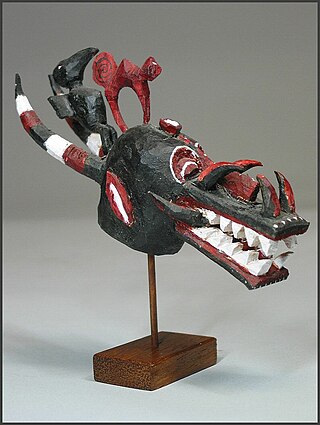
The kponyungo is a ritual mask created by the Senufo people, an ethnolinguistic group residing in Africa's Ivory Coast.
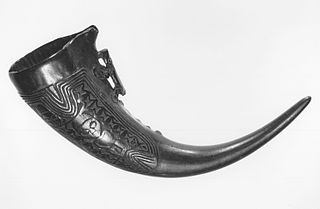
On display in the Art Institute of Chicago, in the African Art and Indian Art of the Americas, is a 19th-century drinking horn. Originally from the Kuba Kingdom, the drinking horn is made out of wood, iron, and copper alloy. Drinking horns were usually a gift to the friends and family of kings or given to a warrior.
The Suku people or Basuku (plural) are an ethnic group of Bantu origin who traditionally inhabit the south-western Democratic Republic of the Congo and north-western Angola. As of 2017, there are believed to be about 200,000 people who identify as Suku, many living in the Congo's Kwango Province.


















